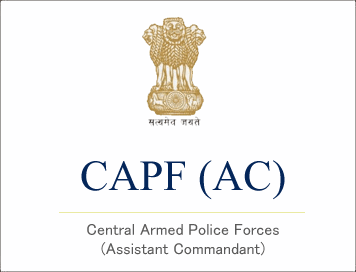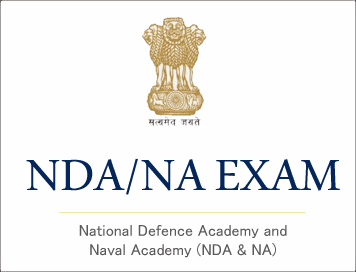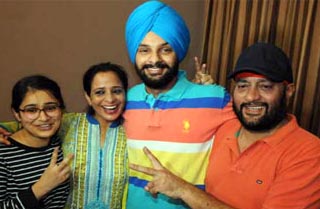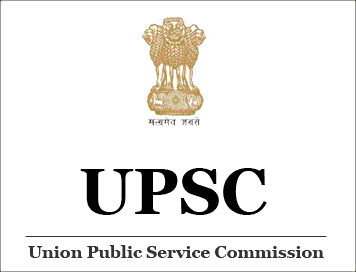
CAPF-AC Solved Papers : 2013
1. The Chipko Movement
1. was an environmental movement to prevent cutting down of trees
2. raised the question of ecological and economic exploitation
3. is a movement against alcoholism as its broadened agenda
4. demanded that local communities should have control over their natural
resources
Select the correct answer using the code given below.
(a) 1 and 2 only
(b) 2 and 3 only
(c) 1, 3 and 4 only
(d) 1, 2, 3 and 4
Ans : (a)
2. The Parliament of India may form a new State by separation of territory
from any State or by unifying any territory to a part of any State. Which of the
following procedures is/are true in this regard?
1. By a simple majority and by the ordinary legislative process
2. On the recommendation of the President, who usually has to refer the bill to
the legislature of the State(s) which is/are going to be affected by the changes
proposed in the bill
3. On the advice of the Prime Minister to the President
Select the correct answer using the code given below.
(a) 1 and 2 only
(b) 1, 2 and 3
(c) 2 only
(d) 1 and 3 only
Ans : (a)
3. A bill introduced in the Parliament, in order to become an Act, has to
have which of the following procedures to be followed?
1. It is to be passed by both the Houses of the Parliament.
2. The President has to give his/her assent.
3. The Prime Minister has to sign it after the ratification by the Parliament.
4. The Supreme Court has to approve and declare it to be within the jurisdiction
of the Parliament.
Select the correct answer using the code given below.
(a) 1 and 2 only
(b) 1, 2 and 3 only
(c) 1, 2, 3 and 4
(d) 3 and 4 only
Ans : (a)
4. Which of the following statements is / are correct?
1. Offices connected with a religious or denominated institution may be
reserved for members professing the particular religion to which the institution
relates.
2. The State may reserve any post or appointment in favour of any backward class
of citizens who, in the opinion of the State, are not adequately represented in
the services under that State.
3. No citizen shall, on grounds of religion, race, caste, sex, descent, place of
birth or any of them, be ineligible for any office under the State.
Select the correct answer using the code given below.
(a) 1 and 2 only
(b) 2 and 3 only
(c) 1, 2 and 3
(d) 3 only
Ans : (d)
5. Consider the following statements:
1. While the Fundamental Rights constitute limitations on State action, the
Directive Principles are in the nature of instruments of instruction to the
government of the day to do certain things and to achieve certain goals by their
actions.
2. The Directive Principles, however, require to be implemented by legislations
and so long as there is no law carrying out the policy laid down in a Directive
Principle, neither the State nor an individual can violate any existing law or
legal rights under the colour of getting a Directive.
3. The Directive Principles are enforceable in the courts and create justiciable
rights in favour of the individual.
Which of the statements given above is / are correct?
(a) 1, 2 and 3
(b) 1 and 3 only
(c) 1 and 2 only
(d) 2 only
Ans : (c)
6. Consider the following statements
1. It shall be the, endeavour of every State and every local authority within
the State to provide adequate facilities for instruction in mother tongue at the
primary state of education to children belonging to linguistic minority groups.
2. The- Constitution enjoins the Union of India to provide and promote the
spread of Hindi language and to develop it, so that it, may serve as a medium of
expression of, all the elements of the composite culture of India.
Which of the ·statements given above is/ are correct?
(a) Only 1
(b) Only 2
(c) Both 1 and 2
(d) Neither 1 nor 2
Ans : (c)
7. Which of the following expenditures is/are charged on the Consolidated
Fund of India?
1. The emoluments and allowances of the President and the expenditure
relating to his/her office.
2. The salaries and allowances of the Chairman and Deputy Chairman of the
Council of States and the Speaker and Deputy Speaker of the House of the People.
3. Debt charges for which the Government of India is liable.
Select the correct answer using the code given below.
(a) 1 and 2
(b) Only 3
(c) 2 and 3
(d) All of these
Ans : (d)
8. Which of the following are the privileges of the House of the People
collectively?
1. The right to' publish debates and proceedings and the right to restrain
publication by others.
2. The right to exclude others to exclude strangers from the galleries anytime.
3. The right to punish members and outsiders for breach of its privileges.
4. What is said or done within the walls of the Parliament, however can be
inquired into in a court of law.
Select the correct answer-using the code given below.
(a) 1, 2 and 3
(b) 3 and 4
(c) 1 and 2
(d) All of these
Ans : (a)
9. A bill is deemed to be a 'Money Bill' if it contains only provisions
dealinq with
1. the imposition, alteration or regulation of any tax.
2. the regulation of the borrowing of money by the government.
3. the custody of the Consolidated Fund of India or the Contingency Fund of
India.
4. the provision for imposition of fines or other penalties or for the demand or
payment of fees for licenses or fees for services rendered.
Select the correct answer using the code given below.
(a) 1, 2 and 3
(b) 1 and 2
(c) 3 and 4
(d) All of the above
Ans : (a)
10. Which of the following statements regarding the powers of the Speaker
of the House of the People is/are correct?
1. The Speaker's conduct in regulating the procedure of maintaining order in
the House will not be subject to the jurisdiction of any court.
2. Besides presiding over his/her own House, the Speaker possesses certain
powers like presiding over a joint sitting of the two Houses of the Parliament".
3. While a resolution for his/her removal is under consideration, the Speaker
shall preside but shall have no right to speak and shall have no right to vote.
Select the correct answer using the code given below.
(a) Only 1
(b) 1 and 2
(c) 2 and 3
(d) All of these
Ans : (b)
11. A person shall be disqualified for being chosen as and for being, a
member of either House of the Parliament if she/he
1. holds' any office of profit under the Government of. India or the
Government of any State, other than an office exempted by the Parliament by law.
2. is of unsound mind and stands, so declared by a competent court.
3. Remains absent from all meetings of the House for a period of 60 days without
the permission of the House.
Select the correct answer using the code given below.
(a) 1 and 2
(b) 2 and 3
(c) 1 and 3
(d) All of these
Ans : (d)
12. Consider the following statements reqarding termination of sitting of
a House
1. Only the House of the People is subject to dissolution
2. The powers of dissolution and prorogation are exercised by the President on
the advice of the Council of Ministers.
3. The power to adjourn the daily sittings of the House, of the People and the
Council: of 'States belongs' to the Speaker and the Chairman respectively.
4. The Parliament cannot be dissolved as it is a permanent chamber.
Which of the statements given above are correct?
(a) 1,2 and 3
(b) 2,3 and 4
(c) 1 and 3
(d) 1, 2 and 4
Ans : (a)
13. Consider the following statements
1. A person who is not a member of either House of the Parliament can be
appointed a member of the Council of Ministers.
2. Anyone can be appointed as a member of the Council of Ministers for a maximum
period of 3 years.
3. A person shall not be less than 25 years of age in order to become a
minister.
Which of the statements given above is/are correct?
(a) 2 and 3
(b) Only 1
(c) 1 and 3
(d) All of these
Ans : (c)
14. The Central Administrative Tribunal adjudicates disputes with respect
to the recruitment and conditions of service of persons appointed
1. to public services and posts in connection with the affairs of the Union.
2. members of the defence forces
3. officers and servants of the Supreme Court or of any High Court in India.
Select-the correct answer using the code given below.
(a) 1 and 2
(b) Only 1
(c) only 2
(d) 2 and 3
Ans : (a)
15. The following are some of the items of expenditure of the Central
Government in India.
1. Interest payments
2. Major subsidies
3. Pensions
4. Loans and advances
Which of the above is/are included in non-plan revenue expenditure?
(a) Only 1
(b) 2 and 3
(c) 1, 2 and 3
(d) 2, 3 and 4
Ans : (c)
16. If we deduct grants for creation of capital assets from revenue
deficit, we arrive at the concept of
(a) primary deficit
(b) net fiscal deficit
(c) budgetary deficit
(d) effective revenue deficit
Ans : (d)
17. Which one among the following items has maximum weight in wholesale
price index in India?
(a) Primary article
(b) Fuel and power
(c) Manufactured product
(d) Food item
Ans : (c)
18. Which among the following agencies disbursed maximum credit to tile
agricultural sector in India between 2006-0J-and 2011-12?
(a) Cooperative banks
(b) Regional rural banks
(c) Commercial banks
(d) Moneylenders
Ans : (c)
19. Consider the following statements
1. Repo Rate is the interest rate at which RBI lends to commercial banks for
short period.
2. Reverse Repo Rate is the interest rate which RBI pays to commercial banks on
short-term deposits.
3. Gap between Repo Rate and Reverse Repo Rate has been declining in India in
the recent past.
Which of 'the statements above is/are not correct?
(a) Only 1
(b) Only 2
(c) Only 3
(d) 2 and 3
Ans : (c)
20. The rate of inflation in India is measured generally in respect of
movement of
(a) consumer price index
(b) wholesale price index
(c) cost of living index for agricultural labour
(d) money supply
Ans : (b)








